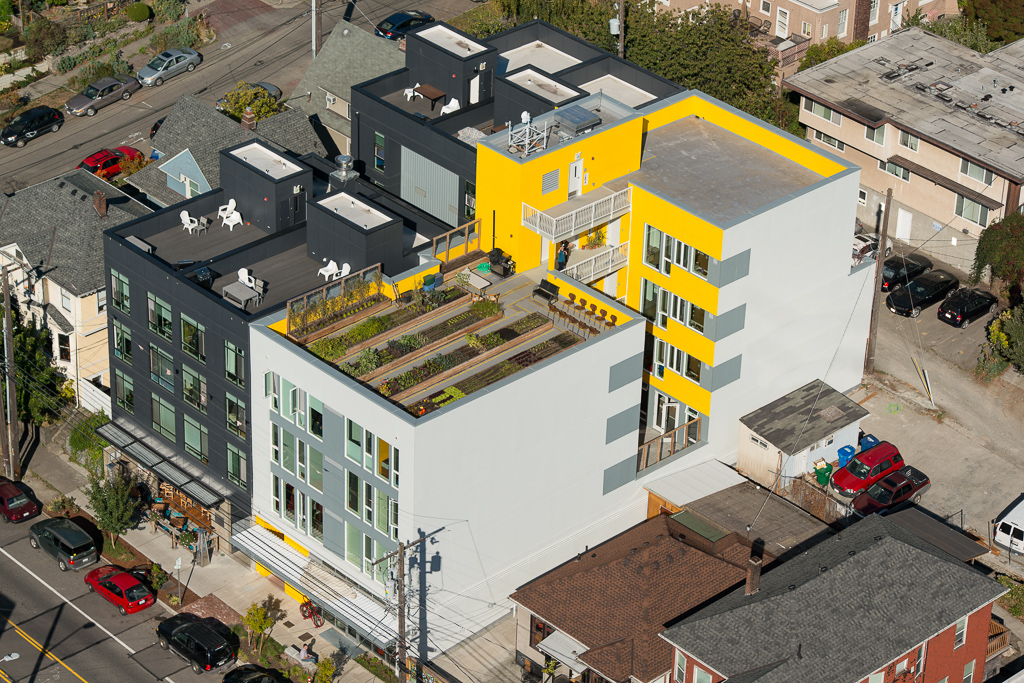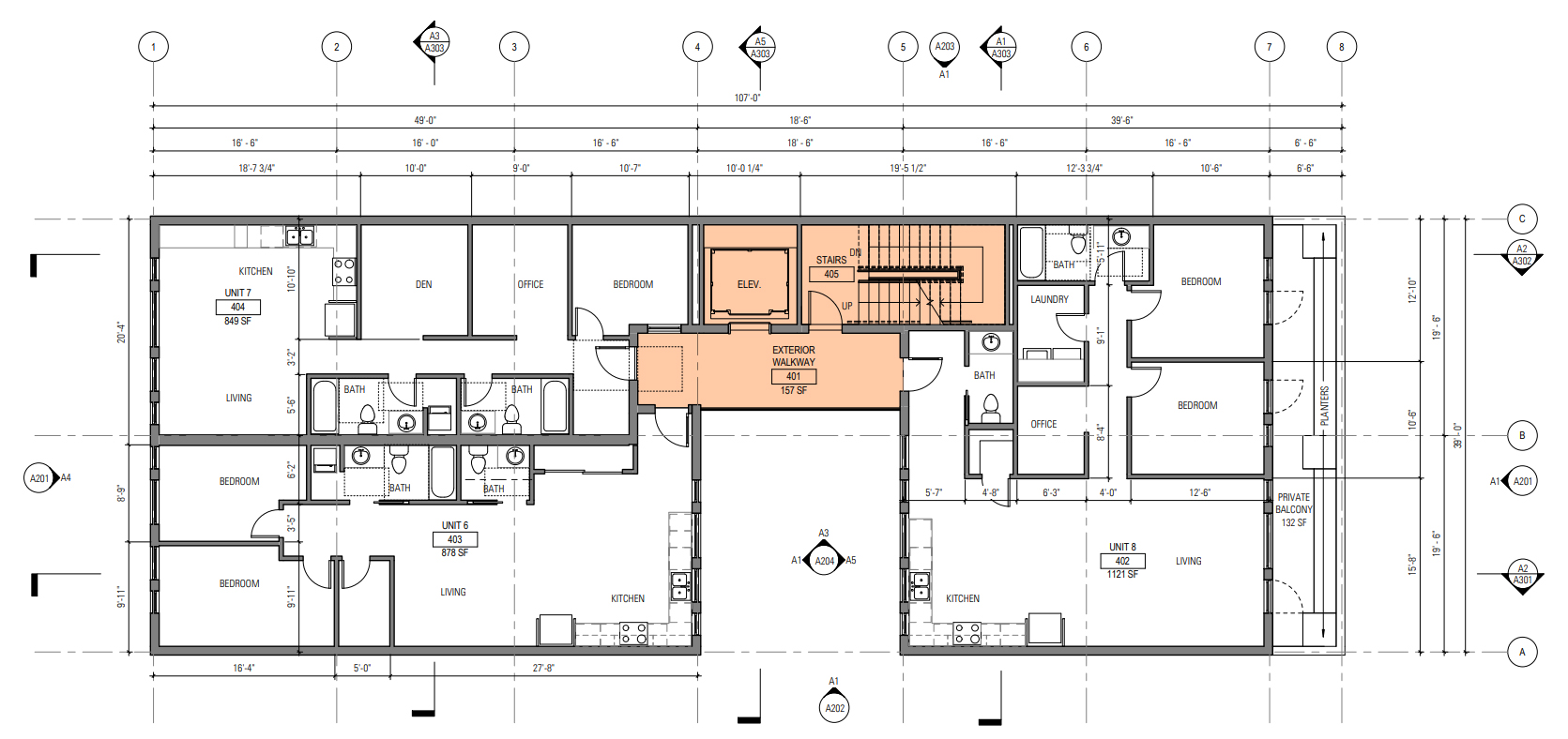Seattle
The Seattle Building Code permits apartment buildings of up to six storeys to be served by a single exit stair.
Seattle is one of the jurisdictions in the United States (along with New York City and the Island of Oahu within the State of Hawaii) to permit single staircase buildings exceeding three storeys and many such projects have been realized in recent years - especially as zoning updates allow more density near public transit. This is not a recent change given Seattle first introduced such conditions in 1977. Seattle’s building officials have described the rationale for the change as “there were many small lots being developed and two exits took up a significant portion of the floor plate.”
The International Building Code (model U.S. building code) allows apartment buildings of up to three storeys to be served by a single exit, while the NFPA 101 Life Safety Code allows up to four storeys to be served by a single exit. Chapter 10 of the 2018 Seattle Building Code outlines the current requirements and additional life safety measures for single exit buildings up to six storeys, including a maximum of four dwelling units per storey (written as ‘story’ in the US) and a requirement for positive pressurization of the exit stair to prevent smoke infiltration.
A read-only version of the document is accessible here.
Seattle is one of the jurisdictions in the United States (along with New York City and the Island of Oahu within the State of Hawaii) to permit single staircase buildings exceeding three storeys and many such projects have been realized in recent years - especially as zoning updates allow more density near public transit. This is not a recent change given Seattle first introduced such conditions in 1977. Seattle’s building officials have described the rationale for the change as “there were many small lots being developed and two exits took up a significant portion of the floor plate.”
The International Building Code (model U.S. building code) allows apartment buildings of up to three storeys to be served by a single exit, while the NFPA 101 Life Safety Code allows up to four storeys to be served by a single exit. Chapter 10 of the 2018 Seattle Building Code outlines the current requirements and additional life safety measures for single exit buildings up to six storeys, including a maximum of four dwelling units per storey (written as ‘story’ in the US) and a requirement for positive pressurization of the exit stair to prevent smoke infiltration.
A read-only version of the document is accessible here.
Seattle Building Code 2018, Chapter 10: Means of Egress
1006.3.3 Single Exits
7. Not more than 5 stories of Group R-2 occupancy are permitted to be served by a single exit under the following conditions:
7. Not more than 5 stories of Group R-2 occupancy are permitted to be served by a single exit under the following conditions:
7.1. The building has not more than six stories above grade plane.
7.2. The building does not contain a boarding house.
7.3. There shall be no more than four dwelling units on any floor.
7.4. The building shall be of not less than one hour fire-resistive construction and shall also be equipped throughout with an automatic sprinkler system in accordance with subsection 903.3.1.1. Residential-type sprinklers shall be used in all habitable spaces in each dwelling unit. (Required anyways)
7.5. There shall be no more than two single exit stairway conditions on the same property.
7.6. An exterior stairway or interior exit stairway shall be provided. The interior exit stairway, including any related exit passageway, shall be pressurized in accordance with subsection 909.20. Doors in the stairway shall swing into the interior exit stairway regardless of the occupant load served, provided that doors from the interior exit stairway to the building exterior are permitted to swing in the direction of exit travel.
7.7. A corridor shall separate each dwelling unit entry/exit door from the door to an interior exit stairway, including any related exit passageway, on each floor. Dwelling unit doors shall not open directly into an interior exit stairway. Dwelling unit doors are permitted to open directly into an exterior stairway,
7.8. There shall be no more than 20 feet (6096 mm) of travel to the exit stairway from the entry/exit door of any dwelling unit.
7.9. Travel distance measured in accordance with section 1017 shall not exceed 125 feet (38100 mm).
7.10. The exit shall not terminate in an egress court where the court depth exceeds the court width unless it is possible to exit in either direction to the public way.
7.11. Elevators shall be pressurized in accordance with section 909.21 or shall open into elevator lobbies that comply with section 713.14. Where approved by the building official, natural ventilation is permitted to be substituted for pressurization where the ventilation would prevent the accumulation of smoke or toxic gases.
7.12. Other occupancies are permitted in the same building provided they comply with all the requirements of this code. Other occupancies shall not communicate with the Group R occupancy portion of the building or with the single-exit stairway. Exception: parking garages and occupied roofs accessory to the Group R occupancy are permitted to communicate with the exit stairway.
7.13. The exit serving the Group R occupancy shall not discharge through any other occupancy, including an accessory parking garage.
7.14. There shall be no openings within 10 feet (3048 mm) of unprotected openings into the stairway other than required exit doors having a one-hour fire-resistance rating.
Examples of Recent Single Staircase Projects in Seattle
Capitol Hill Urban Cohousing
Schemata Workshop (2016)1720 12th Ave, Seattle, WA 98122, USA
Height: 5 storeys (58 ft / 17m)
Use: 9 dwelling units, 1 commercial at grade
Floor Area: 17,600 ft2 / 1,635 m2
Construction: Type V-A (upper floors) and Type I-A (ground)
Stair: Galvanized Steel
Sprinklered: Yes (required throughout)
CHUC is a five-storey co-housing project on a narrow lot (40’ wide by 113’ deep). The architect claims that a second staircase would have changed the design from nine to six family-sized units, and made the project financially unviable as affordable housing. The exterior passageway on each level serves as smoke control measure and also promotes casual interaction between residents across the courtyard. The method of construction is four storeys of protected wood-frame above a ground floor podium of reinforced concrete. The architects wanted to build to the maximum height limit for single exit conditions at six storeys, but were limited by the zoning by-law to a maximum height of five storeys.
Click here for an interview with the architect and co-housing developer, Mike Mariano.






Sources:
CHUC Further Description: https://www.schemataworkshop.com/chuc
CHUC Architectural Drawings: https://capitolhillurbancohousing.org/wp-content/uploads/2015/06/CHUC_MUP-Drawings-abridged.pdf
CHUC Seattle Design Review Proposal: http://www.seattle.gov/dpd/AppDocs/GroupMeetings/DRProposal3013374AgendaID4783.pdf
CHUC Detailed Project Timeline: https://www.ic.org/a-high-performance-building-for-cohousing-from-vision-to-move-in/